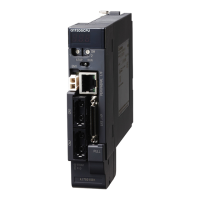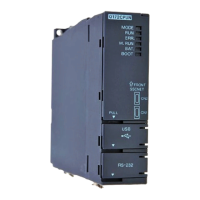6 - 17
6 PARAMETERS FOR POSITIONING CONTROL
6.3.3 Speed control gain 1, 2
(1) Speed control gain 1
(a) For speed control mode
Normally, it is not necessary to change.
(b) For position control mode
Set to increase the follow-up for commands.
(2) Speed control gain 2
(a) This gain is set when vibration occurs, for example in low-rigidity machines
or machines with a large backlash.
If this gain is increased, responsiveness is improved but vibration (abnormal
motor noise) becomes more likely.
(b) A guide to setting position gain 2 is shown in Table 6.5 below.
Table 6.5 Guide to speed control gain 2 setting
Load inertia ratio
(GDL
2
/GDM
2
)
1 3 5 10 20 30 or more Remarks
Setting value [ms] 800 1000 1500 2000 2000 2000
Setting range of 1 to
9999 can be set.
(Valid range: 20 to 5000)
POINTS
(1) When the setting for speed control gain 1 is too high, the overshoot becomes
greater and vibration (abnormal motor noise) occurs on stopping.
(2) The speed control gain 1 setting can be checked using a peripheral device.
(Refer to the help of each software for the monitoring method of the speed
control gain1 using a peripheral device.)
6.3.4 Speed integral compensation
(1) This parameter is used to increase frequency response in speed control and
improve transient characteristics.
(2) If the overshoot in acceleration/deceleration cannot be made smaller by adjusting
speed loop gain or speed control gain, increasing the setting for the speed integral
compensation value will be effective.
(3) A guide to setting the speed integral compensation is shown in Table 6.6 below.
Table 6.6 Guide to speed integral compensation setting
Load inertia ratio
(GDL
2
/GDM
2
)
1 3 5 10 20 30 or more Remarks
Setting value [ms] 20 30 40 60 100 200
Setting range of 1 to 9999
can be set.
(Valid range: 1 to 1000)

